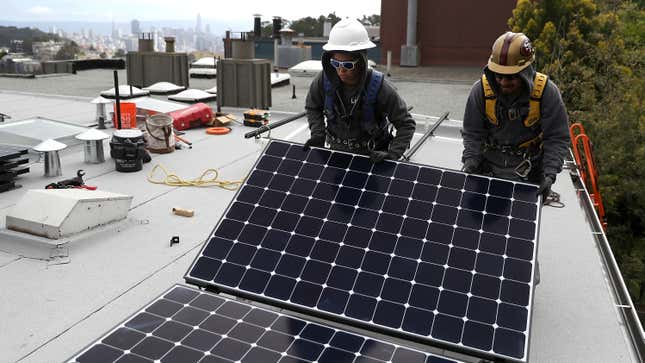
According to the best available climate science, the U.S. needs to completely zero out its carbon pollution by 2050 to secure a livable future. A new analysis from the nonprofit Energy Innovation lays out a plan to get there, which also would just happen to add a cool $1 trillion dollars to the national economy.
Using the U.S. Energy Policy Simulator, an open-source computer model developed by Energy Innovation, the authors determined exactly what policies the government would have to put in place to achieve zeroing out U.S. carbon pollution by 2050.
They determined that the federal government will need to ban coal power by 2030, reach an 80% renewably-powered grid by 2030 and a 100% clean grid by 2035. It will also have to impose 100% zero-emission vehicle standards by 2045 at the latest, requiring all new cars, trucks and buses to run on electricity. Policies will also have to be put in place to retrofit and weatherize buildings and factories so they conserve energy and don’t run on oil or gas. And in the authors’ model, officials will also have to pour resources into developing carbon capture technologies.
This will cost money, of course, but the report shows that the economy versus climate dichotomy is a false one. We already knew from previous work that waiting to decarbonize would end up costing trillions in stranded assets and the shock a more rapid transition to clean energy would be to the economy.
But the new report shows that decarbonizing sooner than later comes with a huge host of co-benefits. The policies necessary to achieve emissions cuts would also result in lowered emissions of other toxic pollution as fossil fuel power plants shutter. If the U.S. follows the course outlined in the report, the U.S. would avoid more than 65,000 premature deaths, nearly 2 million asthma attacks, nearly 38,000 hospital admissions, and more than 6.5 million lost workdays by 2050.
The transition would also create massive employment opportunities to install new technology and create new ones. The authors say it would create 3.1 million job-years (or full-time jobs for a full year) by 2030, and 5.5 million by 2050. This would all increase the nation’s gross domestic product by $500 million by 2030, and by $1 trillion by 2050.
The economy is already tilting in favor of the clean energy transition. Fossil fuels are proving to not be good investments, and sustainable technology is becoming more affordable. Since 2009, the cost of solar panels has fallen by 90%, wind turbines’ cost has dropped 71%, and LED lightbulbs have become 80% cheaper, the authors write. But the transition isn’t happening fast enough, which is why policy measures like the ones outlined in the report make sense from both an economic perspective and a human one.
“Only well-designed policies can drive this technological transformation at the required pace,” the report says. And with co-benefits like this, we have no excuse not to act right now.